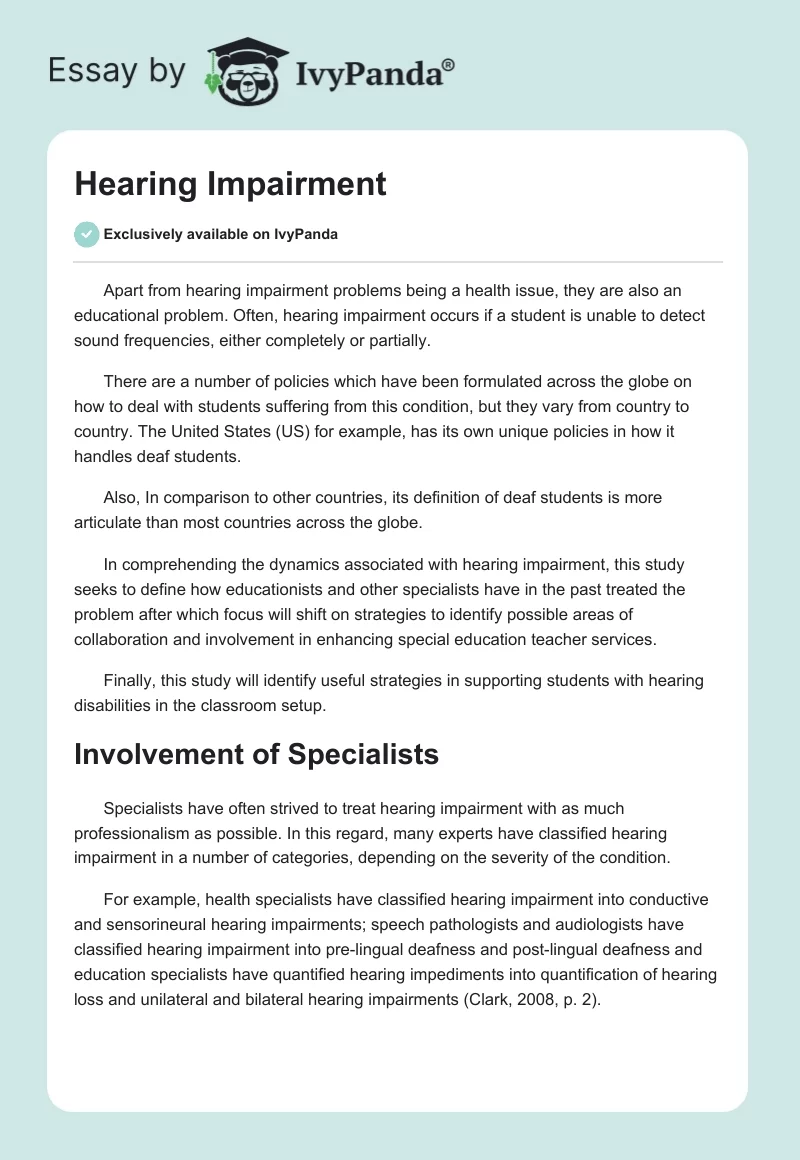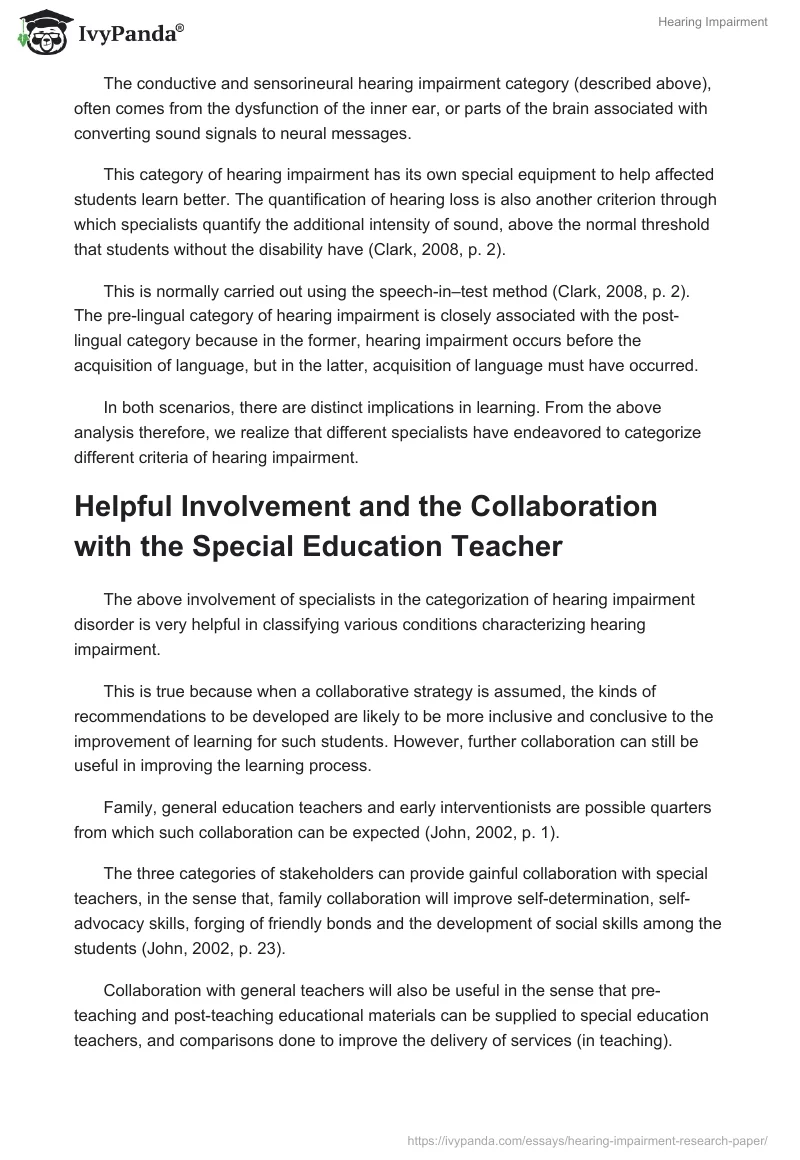Apart from hearing impairment problems being a health issue, they are also an educational problem. Often, hearing impairment occurs if a student is unable to detect sound frequencies, either completely or partially.
There are a number of policies which have been formulated across the globe on how to deal with students suffering from this condition, but they vary from country to country. The United States (US) for example, has its own unique policies in how it handles deaf students.
Also, In comparison to other countries, its definition of deaf students is more articulate than most countries across the globe.
In comprehending the dynamics associated with hearing impairment, this study seeks to define how educationists and other specialists have in the past treated the problem after which focus will shift on strategies to identify possible areas of collaboration and involvement in enhancing special education teacher services.
Finally, this study will identify useful strategies in supporting students with hearing disabilities in the classroom setup.
Involvement of Specialists
Specialists have often strived to treat hearing impairment with as much professionalism as possible. In this regard, many experts have classified hearing impairment in a number of categories, depending on the severity of the condition.
For example, health specialists have classified hearing impairment into conductive and sensorineural hearing impairments; speech pathologists and audiologists have classified hearing impairment into pre-lingual deafness and post-lingual deafness and education specialists have quantified hearing impediments into quantification of hearing loss and unilateral and bilateral hearing impairments (Clark, 2008, p. 2).
The conductive and sensorineural hearing impairment category (described above), often comes from the dysfunction of the inner ear, or parts of the brain associated with converting sound signals to neural messages.
This category of hearing impairment has its own special equipment to help affected students learn better. The quantification of hearing loss is also another criterion through which specialists quantify the additional intensity of sound, above the normal threshold that students without the disability have (Clark, 2008, p. 2).
This is normally carried out using the speech-in–test method (Clark, 2008, p. 2). The pre-lingual category of hearing impairment is closely associated with the post-lingual category because in the former, hearing impairment occurs before the acquisition of language, but in the latter, acquisition of language must have occurred.
In both scenarios, there are distinct implications in learning. From the above analysis therefore, we realize that different specialists have endeavored to categorize different criteria of hearing impairment.
Helpful Involvement and the Collaboration with the Special Education Teacher
The above involvement of specialists in the categorization of hearing impairment disorder is very helpful in classifying various conditions characterizing hearing impairment.
This is true because when a collaborative strategy is assumed, the kinds of recommendations to be developed are likely to be more inclusive and conclusive to the improvement of learning for such students. However, further collaboration can still be useful in improving the learning process.
Family, general education teachers and early interventionists are possible quarters from which such collaboration can be expected (John, 2002, p. 1).
The three categories of stakeholders can provide gainful collaboration with special teachers, in the sense that, family collaboration will improve self-determination, self-advocacy skills, forging of friendly bonds and the development of social skills among the students (John, 2002, p. 23).
Collaboration with general teachers will also be useful in the sense that pre-teaching and post-teaching educational materials can be supplied to special education teachers, and comparisons done to improve the delivery of services (in teaching).
Finally, collaboration between early interventionist can help special teachers understand how best to solve unique student learning problems because early interventionists normally have a lot of experience on how the condition should be best handled.
Behavioral Management Strategies
Reducing off-task behaviors (by teachers) can be an effective instruction strategy to help deaf students keep their behaviors in check (in and out of the classroom set up).
This should be done by ensuring that other normal students are acting as mentors; or at least as role models for the hearing impaired students (as a strategy to induce positive peer influence in the school environment).
The same cue can also be imposed on deaf students to prevent them from taking part in any disruptive behavior.
In this regard, Barbara (2009, p. 5) explains that “An auditory cue can be used that has been established between the teacher and the student to redirect hearing impaired student’s management issues”.
This strategy will further reinforce recommendations to uphold appropriate behavior in the school setup.
Making the students repeat the rules and policies of acceptable classroom behaviors and the eminent consequences for such behaviors, is also important in ensuring students maintain good behaviors, in and out of the classroom setups.
This strategy can be complimented by teachers who staple a written document of such rules on notebooks, so that students are constantly reminded of the right or appropriate behaviors to uphold.
Conclusion
Teaching hearing impaired students can be a challenging but manageable task. This study identifies the need for increased collaboration and inclusiveness among early interventionists, families and general teachers to improve teaching services.
This initiative need to be perfectly complimented by appropriate teaching strategies to provide a holistic learning experience for this special group of students because it is possible to provide them with comprehensive education, just like other students.
References
Barbara, A. (2009). Classroom Management Strategies for Hearing Impaired Students. Web.
Clark, L. (2008). Learning Disability and Other Intellectual Impairments: Meeting Needs Throughout Health Services. London: John Wiley and Sons.
John, L. (2002). Suggestions for Helping Students Who Are Deaf Succeed in General Education Settings. Communication Disorders Quarterly, 24(1), 23-30.


